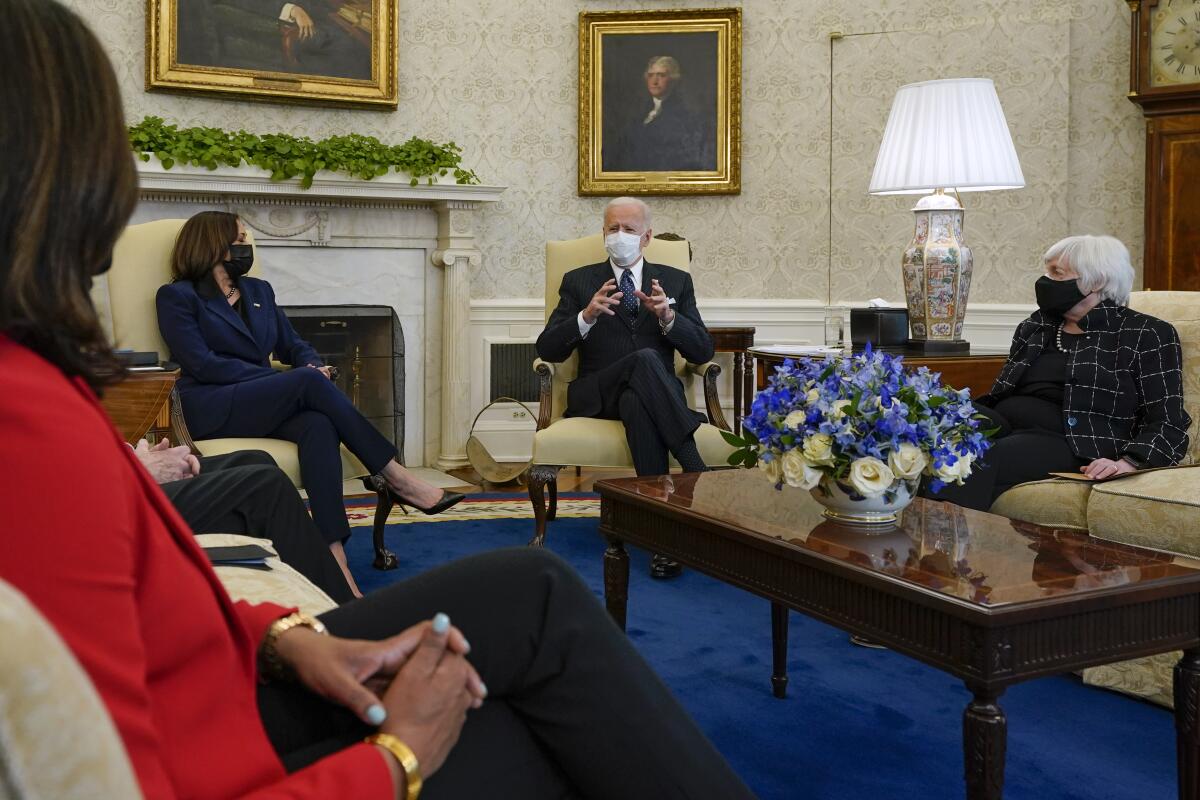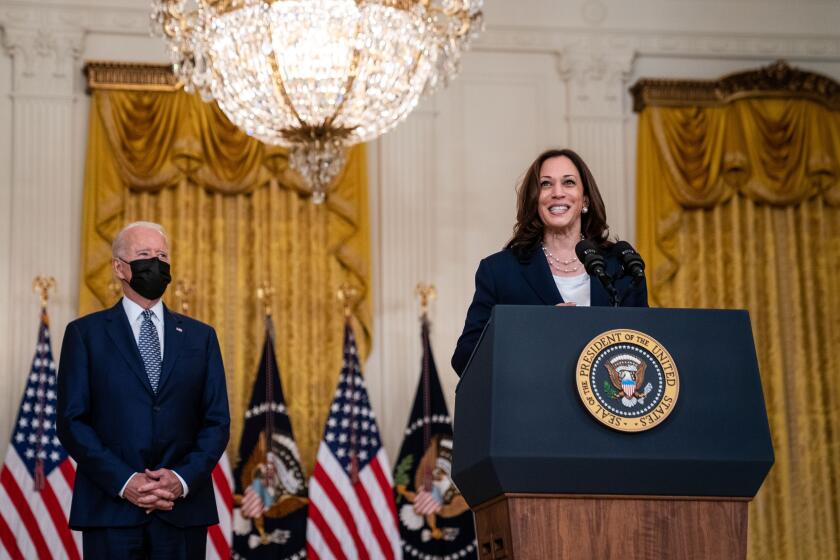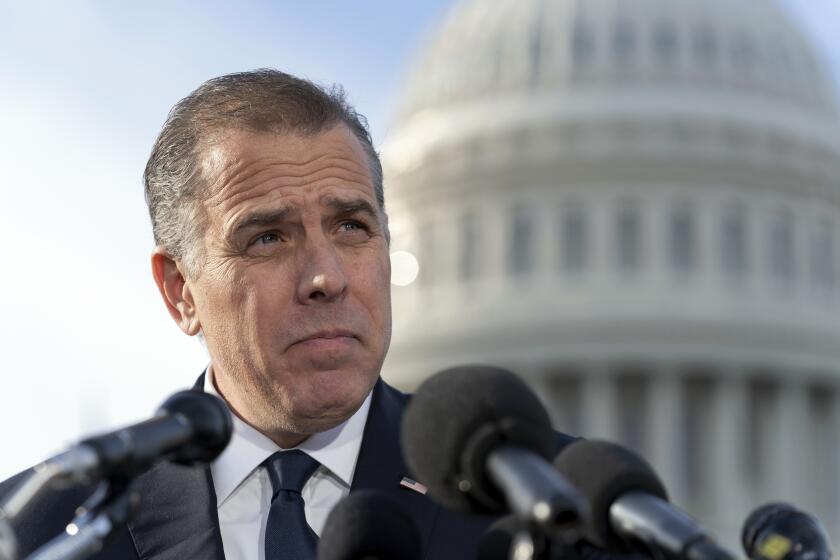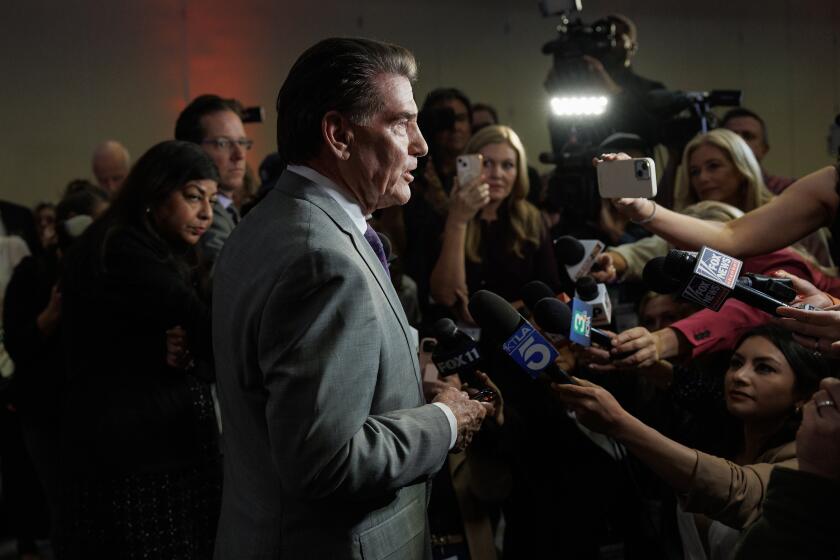Essential Politics: Biden’s senior appointments are almost 60% women. He’s on track for a historic milestone

This is the March 26, 2021, edition of the Essential Politics newsletter. Like what you’re reading? Sign up to get it in your inbox three times a week.
With his Cabinet confirmed and a significant share of other senior appointments in place, President Biden is on track to achieve something never before seen in the U.S. — an administration with a majority of senior positions filled by women.
For the record:
12:18 p.m. March 30, 2021This newsletter incorrectly states that after Frances Perkins in the Franklin D. Roosevelt administration, no woman headed a Cabinet department until 1975. Oveta Culp Hobby served as the first secretary of Health, Education and Welfare under President Eisenhower from April 1953 to July 1955.
Through Friday morning, Biden has nominated or announced 84 senior appointments that require Senate confirmation — 24 in his Cabinet and 60 to sub-Cabinet positions and senior spots in federal agencies — and 56% of those appointments have gone to women. Among the sub-Cabinet positions, just over 60% have gone to women, including Rachel Levine, whose confirmation as assistant secretary for health at the Department of Health and Human Services made her the first openly transgender person to win Senate approval.
Nearly half the sub-Cabinet nominations to date have gone to people of color.
The administration has also named hundreds of people to staff jobs that don’t require a Senate vote, and while the statistics aren’t complete on those, the same pattern appears to be holding true.
Get our L.A. Times Politics newsletter
The latest news, analysis and insights from our politics team.
You may occasionally receive promotional content from the Los Angeles Times.
The administration is, of course, still in its early going, and Biden has hundreds more senior positions to fill at federal departments, boards and agencies, not to mention nominations of federal judges — the first wave of those could come as early as next week — and ambassadors, which are also likely to start rolling out in April.
So the percentages could still change, but the share of top posts going to women has stayed consistent so far. They show that Biden has made significant strides on a campaign promise that matters to a large number of Democratic voters.
Impact of diversity
The quest for diversity in appointments hasn’t been entirely smooth for Biden. The inner circle of long-time advisors around him are men, with the exception of his sister, Valerie Biden Owens, who managed his first Senate campaign and has remained a close advisor.
During the campaign, Biden successfully widened that circle. Then, in the transition, amid competition for a limited supply of Cabinet slots, advocates for historically underrepresented groups each pressed the Biden team to do more.
That pressure has continued. Last week, for example, Sens. Tammy Duckworth of Illinois and Mazie Hirono of Hawaii briefly threatened to hold up confirmation of some nominees to protest the shortage of Asian Americans in the Cabinet. Although Katherine Tai, the U.S. trade representative, has Cabinet rank, none of the 15 traditional Cabinet departments is headed by an Asian American.
The next flash point on that debate likely will come as Biden decides who will replace Neera Tanden, a woman of Indian descent, as his nominee to head the Office of Management and Budget, a Cabinet level post.Tanden withdrew her name last month after it became clear that her nomination would not get through the Senate.
Many members of Congress have publicly supported Shalanda Young, who was sworn in Friday as OMB’s deputy director and will serve as the budget office’s acting chief. Young is a Black woman. But Rep. Judy Chu (D-Monterey Park), who chairs the congressional Asian Pacific American Caucus, is among the AAPI leaders calling for someone from their community to get that post.
Even as that issue gets hashed out, Biden’s appointments so far have set new marks for diversity. Of the traditional Cabinet departments, only six are headed by white men, and one of them, Secretary of Transportation Pete Buttigieg, is the first openly gay man to head a Cabinet department.
“President Biden believes that the full participation of everyone — including women and girls — across all aspects of our society is essential to the well-being, health, and security of the United States, and to making our government more representative,” White House Deputy Press Secretary Karine Jean-Pierre said in a statement.
“We are proud that throughout the administration, including at the White House, the leadership is majority women, and we remain committed to building an administration that is reflective of America.”
On gender, Biden’s record so far represents “a point of significant progress,” said Kelly Dittmar, a political scientist at the Center for American Women and Politics at Rutgers University in New Jersey.
On the eve of World War II, what was then known as the Women’s Bureau at the Department of Labor prepared a report on women’s employment in government for Frances Perkins, President Franklin D. Roosevelt‘s secretary of Labor — the first woman to hold a Cabinet post.
Women made up one-fifth of the federal workforce at that point, “largely, as before, in the usual clerical fields,” the report said.
That picture changed, but only gradually. After Perkins, no woman headed a Cabinet agency until 1975, when President Ford appointed Carla Hills to head the department of Housing and Urban Development.
Into the 1990s, such appointments remained scarce, Dittmar said. When President Clinton won election in 1992, he pledged to make diversity a major aspect of his appointments, and his administration set a high point for women in the Cabinet that none of his successors matched until Biden.
Biden, she said, had set a “new benchmark” against which future administrations will be measured.
Notably, a large share of the appointees to date — both men and women — have children living at home, although precise statistics are hard to come by. That’s significant given the attention in recent years to the question of whether senior government jobs are set up in ways that make them difficult for parents to manage.
Statistics can measure the change; gauging the impact is harder.
“Just because a woman is elected or appointed doesn’t mean you all of a sudden get a childcare bill passed,” said Dittmar. But bringing a greater diversity of voices and experiences into debates clearly changes both the nature of the discussion and the outcomes, she added, helping officials avoid blind spots and expanding the range of ideas that go into developing policies.
That’s true throughout the government, said Max Stier, president of the nonprofit Partnership for Public Service, an organization that works with elected officials of both parties to improve the effectiveness of government.
“A diverse workforce produces better results for organizations,” Stier said. In government, that’s both “a performance issue and a representation issue,” he added, since citizens in a democracy have a reasonable expectation that the experiences and perspectives of their diverse communities will be reflected in their leaders.
“The government has come some distance, but it still has a fair ways to go” to reflect the diversity of the U.S. population, Stier said. That’s especially true in the upper ranks of the civil service, which remains predominantly white, the Partnership’s statistics show.
Administrations can directly shape the roughly 4,000 political appointments they fill, ranging from Cabinet secretaries down to relatively low-level staff jobs — a number that has doubled since the 1960s and which Stier believes is now far too large.
Diversifying the much larger civil service is a longer-term process since the ranks turn over much more slowly than political appointees, which change with each administration. Most federal agency workforces, however, have grown more diverse in the last couple of decades.
That reflects, in part, the changing politics of diversity.
On the Democratic side, diversity has risen in importance to the party’s voters. For Republicans, it’s a different story.
Indeed, as polarization has hardened between the parties, especially on issues of identity, a backlash constituency has developed among a significant share of Republicans.
In a major survey last fall, the nonpartisan Public Religion Research Institute found that majorities of Americans agreed that there is a lot of discrimination against Black people (75%), Latinos (69%), and Asian Americans (55%).
Among Republicans, however, that was a much less widely held view. About half of Republicans, 52%, said Black people are subject to a lot of discrimination in the U.S. while even fewer said so regarding Latinos, 45%, or Asian Americans, 32%.
A larger share of Republicans said they saw a lot of discrimination against white people, 57%, or Christians, 62%.
On gender issues, that survey found 60% of Republicans said that society too often punishes men just for acting like men, and 63% said that American society had become too feminine. Only about one-third of self-identified independents and one-quarter of Democrats held that view.
“While there are huge positives of greater diversity, to some people that can be seen as a threat to their power” or the status of their group in society, Dittmar said, and that sort of backlash can have an impact.
The fact that the number of women in senior positions fell off after Clinton’s second term “demonstrates that progress is not inevitable.”
Biden’s first news conference
The president held his first formal news conference on Thursday, and as Chris Megerian wrote, it provided a glimpse of post-COVID challenges, as the pandemic, which has dominated news coverage for a year, went almost without mention after Biden’s opening statement.
If you want a quick refresher, here are five takeaways from Biden’s news conference.
The topic that dominated the questioning was the situation on the border. Earlier this week, Biden announced that Vice President Kamala Harris will lead the administration’s diplomatic response to migrant issues. That reprised a role which Biden filled in the Obama administration, but as Noah Bierman, Megerian and I wrote, it hands Harris a politically complex problem to deal with.
Ahead of the news conference, Megerian looked at Biden’s new verbal discipline, a change for a politician known for garrulousness during much of his career.
Enjoying this newsletter? Consider subscribing to the Los Angeles Times
Your support helps us deliver the news that matters most. Become a subscriber.
Investigating the Capitol riot
The Justice Department alleged in a court filing this week that the Oath Keepers militia and the Proud Boys coordinated plans for the assault on the Capitol. As Del Wilber reported, that’s a further sign of the expanding nature of the investigation into the assault and could presage broader charges.
As more defendants are brought into court, judges have been banning some Capitol suspects from the internet, Evan Halper wrote. Those moves raise 1st Amendment questions that are “uncharted waters,” legal experts said.
In a related issue, lawmakers at a hearing this week warned Google, Facebook and Twitter: More regulation is coming.
Voting rights
Georgia this week became the first state to pass new voting restrictions this year. It likely won’t be the last. As Erin Logan wrote, Republicans in dozens of states are pushing voting restrictions.
The latest from Washington
Alex Padilla is California’s first Latino senator. Sarah Wire talked with him and looked at the issue he has focused on so far — immigration reform. Can he break Washington’s gridlock?
The Supreme Court expanded the meaning of “seizure” under the 4th Amendment in a decision this week, David Savage wrote. The case saw a split in the court’s conservative bloc, with Chief Justice John G. Roberts Jr. and Justice Brett M. Kavanaugh joining the three liberals in the majority.
The new cold war with China could be a good thing, Doyle McManus wrote in his column.
The latest from California
National Republicans have gone all in on the Gavin Newsom recall, Mark Barabak wrote: They’re doing the governor a big favor. In the heavily Democratic state, one of Newsom’s main strategies is to depict the recall as a partisan issue.
The state Supreme Court issued a major ruling that limits the use of cash bail to detain defendants who don’t have the money to post bond, as Maura Dolan wrote.
“The common practice of conditioning freedom solely on whether an arrestee can afford bail is unconstitutional” under the California Constitution, Justice Mariano-Florentino Cuéllar wrote for the unanimous court. Judges must consider a defendant’s ability to pay when setting bail amounts, the court said.
Stay in touch
Send your comments, suggestions and news tips to politics@latimes.com. If you like this newsletter, tell your friends to sign up.
Until next time, keep track of all the developments in national politics and the Trump administration on our Politics page and on Twitter at @latimespolitics.
Get the L.A. Times Politics newsletter
Deeply reported insights into legislation, politics and policy from Sacramento, Washington and beyond. In your inbox three times per week.
You may occasionally receive promotional content from the Los Angeles Times.




